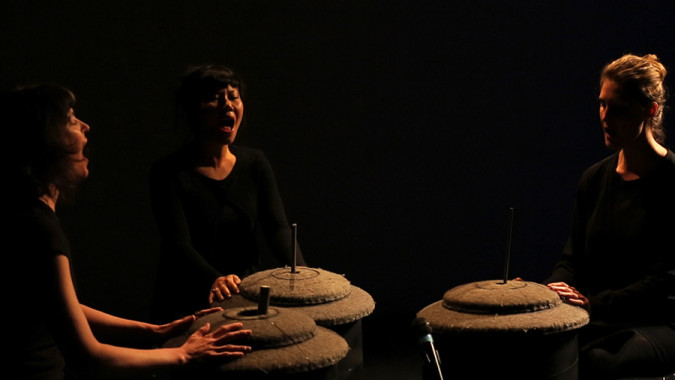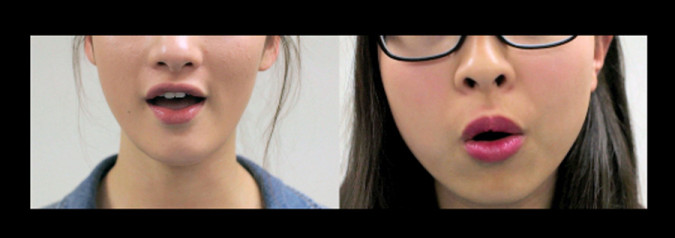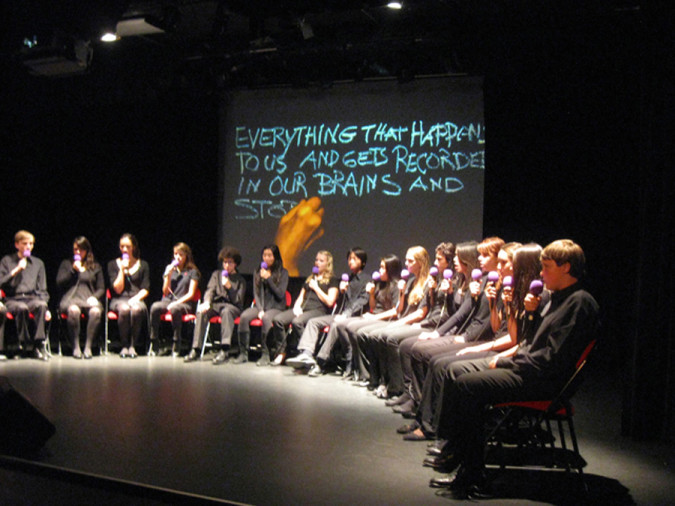Nene Humphrey
Question:
Your work is engaged with a number of different media. You have integrated conversations with neuroscientist Joseph LeDoux into performances using word syllables and breathing patterns. In collaboration with Roberto C. Lange you have worked with choral groups and video projections. how are dreams important to the development of your work?
Answer:
I’ve always included dreams in the journals I’ve kept for many years. Every once in a while I have a dream that impacts my work in dramatic ways. This was the case with a dream I had a few months after my husband died unexpectedly from a rare form of cancer. In the dream I was back where he grew up in Plainview GA, outside the country church where everyone in the community gathered on Sundays. The service was in celebration of my husband’s life. All the church ladies were together on one side of the pulpit and beckoning me to come in and sit at their feet so I could learn their songs and sing with them. There was an awesome power in our voices as we sang together. Through the dream I understood that the human voice is a compelling instrument of the emotional body and can express what is otherwise indescribable.
I woke up with an overwhelming urge to continue singing, something I’d never seriously considered before.
I recounted the dream to a friend who suggested a workshop she had taken with Ysaye Barnwell [One of the singers in the acapella group Sweet Honey in the Rock.] called Building a Vocal Community. There were two spots left and I signed up. The only requirement was a wiliness to sing. We started with traditional songs from Africa and worked our way through ring shouts, hymns, folk and civil rights songs. We sang all day, every day for five days straight and I was hooked. I realized that singing gave me a way to express myself in a new and deeply visceral way, and I wanted to find ways to incorporate voice into my performative work. For example, In Everything that happens, a teenage choir sings about the synaptic events in the amygdala (the emotional brain) using text reorganized according to neural pathways instead of the traditional sentence structure. Video projections of their mouths, dissolving text and brain imagery weave in and out of the performance.
Another example is Circling the Center which weaves film images of animated MRIs, electronic circuitry, and Victorian mourning braiding with sounds of rats serenading each other in a lab, metronomes, and chanted braiding pattern instructions. A choir accompanies a cellist, a woman weaves shimmering red wire, and three performers sing a vocal lament in this expansive infusion of science, art, and emotion.
www.nenehumphrey.com
Circling the Center
Everything that happens
Everything that happens was made in collaboration with composer Roberto C.Lange and is based on a transcribed conversation with neuroscientist, Joseph LeDoux, about the synapticevents in the brain. The choral score uses a simple system employing word syllables, vowels and breathing patterns. Video and text projections weave in and out of the piece.
Neuroscience meets meditation in Circling the Center’s visceral liturgy of sound, film, and live performance. The 45 minute work weaves images of animated MRIs, electronic circuitry and mourning braiding with sounds of rats serenading each other in a lab, metronomes, and chanted braiding pattern instructions. A choir accompanies a cellist, a woman weaves shimmering red wire, and performers sing a vocal lament in this expansive fusion of science, art, and emotion.

Circling the Center- Performance Still: Lament sung by Julie DeLano( composer),Susan Hwang,Leslie Graves, Dixon Place Theater, NYC, May 1st, 2013
One Question/One Answer is a series of very, very brief conversations about art and life between Romanov Grave and a variety of extraordinarily interesting artists.







